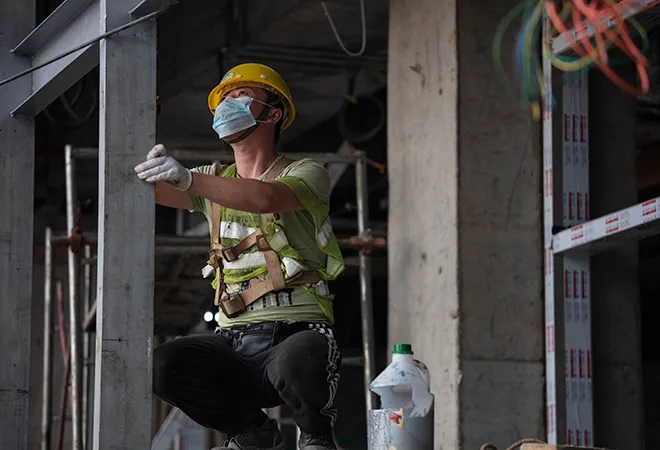
The emerging “worldwide webs” of trade and investment are once again bringing change to relative power balances in the current international system. These economic tracks reflect, and further engender, changing geographies of trade flows, security architecture, and political influence. China’s Belt and Road Initiative (BRI) is one such contemporary blueprint that is resulting in a reorientation of the present power dispensation into one that establishes Beijing as a dominant hub. A focus on the BRI is particularly pertinent, given China’s increasing role in multiple narratives that define the global governance space: globalisation, development finance, sustainable development, innovation and technology.
The idea of “connectivity” and connectivity projects today is being debated along multiple axes: concept, intent, scope, approach, impact, response.
The asset
One layer of conversation is occurring over the implementation of connectivity concepts on the ground. The BRI, for instance, is primarily being rolled out through infrastructure connectivity (roads railways, highways, ports, pipelines) and Chinese firms “going out.” There are other layers envisioned (notably at the financial and policy levels) and an inevitably expanding remit (both geographically and in areas of engagement). A lack of clarity on the bigger picture notwithstanding, there is also a lack of clarity on the functionality of assets being planned and created under the BRI umbrella (Sri Lanka’s Hambantota port is a poster child). Are these projects commercially viable, or do they represent China with the opportunity to convert loss-making projects into strategic assets?
A lack of clarity on the bigger picture notwithstanding, there is also a lack of clarity on the functionality of assets being planned and created under the BRI umbrella (Sri Lanka’s Hambantota port is a poster child).
Syed Kazem Sajjadpour identified two concepts that can prove useful in identifying and implementing win-win projects: “bridge” and “commonality.” The first refers to the intention of physical connectivity, and the second, to the motivation behind such projects. “Chabahar is an example of real connectivity,” as per Sajjadpour. Chabahar is a physical link between India, Iran, and Central Asia, and a conceptual bridge between the development, security, and stability of Afghanistan and the surrounding regions. It also represents commonality of interests between Iran, India, and Afghanistan, which, importantly, are not against the interests of others.
The methodology
Much contention today also revolves around the standards being set, processes being followed, and rules being applied in this area of connectivity. Vijay Gokhale stressed this very point: “it is nobody’s case that infrastructure shouldn’t be built. The issue is how it is to be built.” Connectivity projects must be demand-driven, consultative, and inclusive; they must respect sovereignty and territorial integrity; they must be transparent, free, and open. Amid report of Chinese “debt-trap diplomacy” and concerns of control in BRI projects, it is critical to discuss whether an emerging power is creating an unsustainable ecosystem of dependency, and how to ensure that the setting and pursuit of rules and norms remains a multilateral exercise. The stakeholders A third element increasingly grabbing media and dialogue space is the question of who is driving forward the connectivity agenda. Like other policy areas, nation states are no longer the sole actors, but also sub-national units (cities and provinces). Critically, resource mobilisation cannot involve only state capital, which pales in comparison to the annual $1.7 trillion requirement for infrastructure development across Asia-Pacific. Effectively, private sector and private finance will need to become greater and functional parts of the infrastructure connectivity story. As Nisha Biswal commented, “connectivity is more than just infrastructure… it is about creating that economic activity… That is going to be done through the private sector… through people-to-people and business-to-business exchanges.” The impact of non-market resources on the ground is a related point of debate: does the investment sufficiently answer to the aspirations of many?
Balancing connectivity, balancing power
Inevitably, a bricks and mortar conversation on connectivity can only occur against the strategic backdrop of what is effectively a rising power with increasing means to shape a world that is in transition towards a multipolar world. To reiterate, connectivity itself is a vehicle reorganising the international order. Each of the layers of conversation identified above reflects how economic tracks can carry political cargo — whether through the creation of strategic assets; through the unilateral setting of rules and process that can create dependency and expand political influence; or through a dedicated state-led pursuit that can leverage economic objectives for larger foreign policy goals.
Inevitably, a bricks and mortar conversation on connectivity can only occur against the strategic backdrop of what is effectively a rising power with increasing means to shape a world that is in transition towards a multipolar world.
It is no surprise, then, that connectivity is becoming a contested space. Already, competing narratives are emerging. The BRI today faces, for instance, the Indo-Japan Asia-Africa Growth Corridor, and multiple iterations of the “Indo-Pacific.” Second, competing vantage points exist. India’s stance towards the BRI, for instance, is not the same as Hungary’s, an eager BRI participant. As Istavan Mikola clarified, “We believe that increasing global competition generates global growth and this means increasing opportunities to diversify economic relations, especially to smaller countries like Hungary.” The existence of multiple initiatives could effectively reinforce more inclusive and multi-directional connectivity — but this can only occur if there is balance of power that enforces an open and multipolar system. Therefore, lastly, competing competencies are in focus. “We need to be mindful of our own relative power positions,” noted Zalmay Khalilzad, and it is here that partnerships are effectively coming into play — both through the process of diversification of partners, and the attempt towards bilateral, plurilateral, and multilateral convergence.
The views expressed above belong to the author(s). ORF research and analyses now available on Telegram! Click here to access our curated content — blogs, longforms and interviews.



 The emerging “worldwide webs” of trade and investment are once again bringing change to relative power balances in the current international system. These economic tracks reflect, and further engender, changing geographies of trade flows, security architecture, and political influence. China’s Belt and Road Initiative (BRI) is one such contemporary blueprint that is resulting in a reorientation of the present power dispensation into one that establishes Beijing as a dominant hub. A focus on the BRI is particularly pertinent, given China’s increasing role in multiple narratives that define the global governance space: globalisation, development finance, sustainable development, innovation and technology.
The idea of “connectivity” and connectivity projects today is being debated along multiple axes: concept, intent, scope, approach, impact, response.
The emerging “worldwide webs” of trade and investment are once again bringing change to relative power balances in the current international system. These economic tracks reflect, and further engender, changing geographies of trade flows, security architecture, and political influence. China’s Belt and Road Initiative (BRI) is one such contemporary blueprint that is resulting in a reorientation of the present power dispensation into one that establishes Beijing as a dominant hub. A focus on the BRI is particularly pertinent, given China’s increasing role in multiple narratives that define the global governance space: globalisation, development finance, sustainable development, innovation and technology.
The idea of “connectivity” and connectivity projects today is being debated along multiple axes: concept, intent, scope, approach, impact, response.
 PREV
PREV


